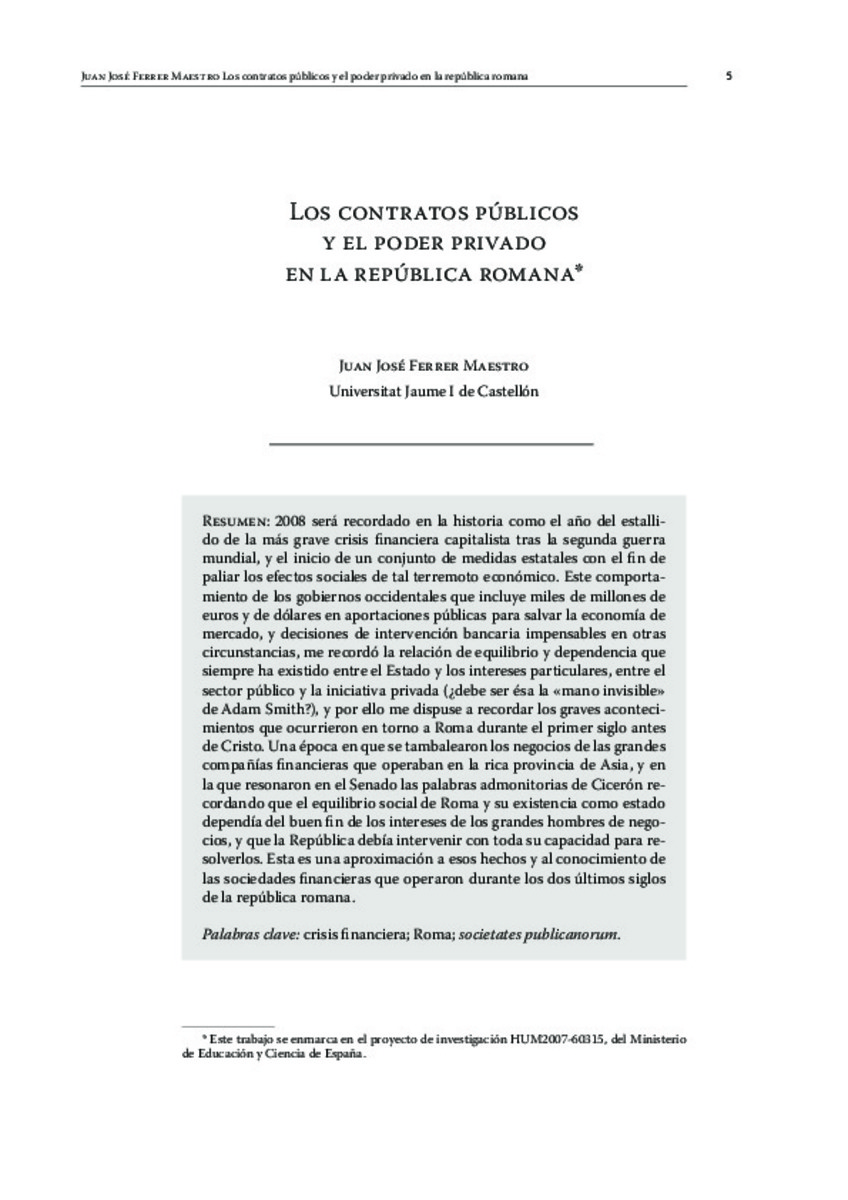Mostrar el registro sencillo del ítem
Los contratos públicos y el poder privado en la República romana
| dc.contributor.author | Ferrer-Maestro, Juan José | |
| dc.date.accessioned | 2012-06-25T11:09:09Z | |
| dc.date.available | 2012-06-25T11:09:09Z | |
| dc.date.issued | 2009 | |
| dc.identifier.citation | Potestas nº 2-2009 | ca_CA |
| dc.identifier.issn | 1888-9867 | |
| dc.identifier.uri | http://hdl.handle.net/10234/42161 | |
| dc.description.abstract | The year 2008 will be remembered in history as the year of the most serious capitalist fi nancial crisis since the outbreah of World War, and as the beginning of state measures taken to mitigate the social eff ects of the economic earthquake. Th is behaviour of Western governments, which includes millions of euros and dollars in public contributions to save the market economy and decisions to intervene in banking that would have been unthinkable in other circumstances, reminded me of the relationship of equilibrium and dependency that has always existed between the state and private interests, between the public sector and private initiative (is this the „invisible hand“ of Adam Smith?). Th at is why I was led to remember the serious events that aff ected Rome in the fi rst century before Christ. Th is was a period when the business of the big fi nancial companies operating in the rich province of Asia were shaken and when the Senate resounded to the warning words of Cicero, recalling that the social equilibrium of Rome and its existence as a State depended on the successful outcome of the interests of the great businessmen, and urging the Republic to intervene with all its power to resolve them. Th is is an approach to those events and to fi nding out about the fi nancial fi rms operating during the last two centuries of the Roman republic. | ca_CA |
| dc.description.abstract | 2008 será recordado en la historia como el año del estallido de la más grave crisis fi nanciera capitalista tras la segunda guerra mundial, y el inicio de un conjunto de medidas estatales con el fi n de paliar los efectos sociales de tal terremoto económico. Este comportamiento de los gobiernos occidentales que incluye miles de millones de euros y de dólares en aportaciones públicas para salvar la economía de mercado, y decisiones de intervención bancaria impensables en otras circunstancias, me recordó la relación de equilibrio y dependencia que siempre ha existido entre el Estado y los intereses particulares, entre el sector público y la iniciativa privada (¿debe ser ésa la «mano invisible» de Adam Smith?), y por ello me dispuse a recordar los graves acontecimientos que ocurrieron en torno a Roma durante el primer siglo antes de Cristo. Una época en que se tambalearon los negocios de las grandes compañías fi nancieras que operaban en la rica provincia de Asia, y en la que resonaron en el Senado las palabras admonitorias de Cicerón recordando que el equilibrio social de Roma y su existencia como estado dependía del buen fi n de los intereses de los grandes hombres de negocios, y que la República debía intervenir con toda su capacidad para resolverlos. Esta es una aproximación a esos hechos y al conocimiento de las sociedades fi nancieras que operaron durante los dos últimos siglos de la república romana. | ca_CA |
| dc.format.extent | 32 p. | ca_CA |
| dc.format.mimetype | application/pdf | ca_CA |
| dc.language | spa | ca_CA |
| dc.language.iso | cat | ca_CA |
| dc.publisher | Universitat Jaume I. Grupo Europeo de Investigación Histórica | ca_CA |
| dc.rights.uri | http://creativecommons.org/licenses/by-sa/4.0/ | * |
| dc.subject | Crisis financiera | ca_CA |
| dc.subject | Roma | ca_CA |
| dc.subject | Societates publicanorum | ca_CA |
| dc.subject | Financial crisis | ca_CA |
| dc.subject | Rome | ca_CA |
| dc.subject.other | Història -- Revistes | ca_CA |
| dc.subject.other | Religió i política -- Revistes | ca_CA |
| dc.title | Los contratos públicos y el poder privado en la República romana | ca_CA |
| dc.type | info:eu-repo/semantics/article | ca_CA |
| dc.identifier.doi | http://dx.doi.org/10.6035/Potestas | |
| dc.rights.accessRights | info:eu-repo/semantics/openAccess | ca_CA |
| dc.type.version | info:eu-repo/semantics/publishedVersion |
Ficheros en el ítem
Este ítem aparece en la(s) siguiente(s) colección(ones)
-
HIS_Articles [430]
Articles de publicacions periòdiques -
Potestas_2009_ no.2 [11]








